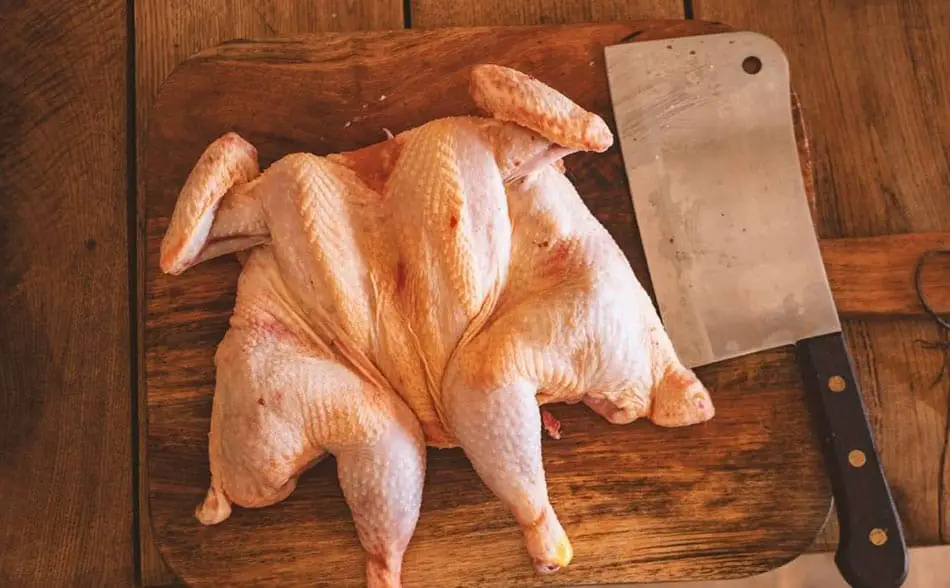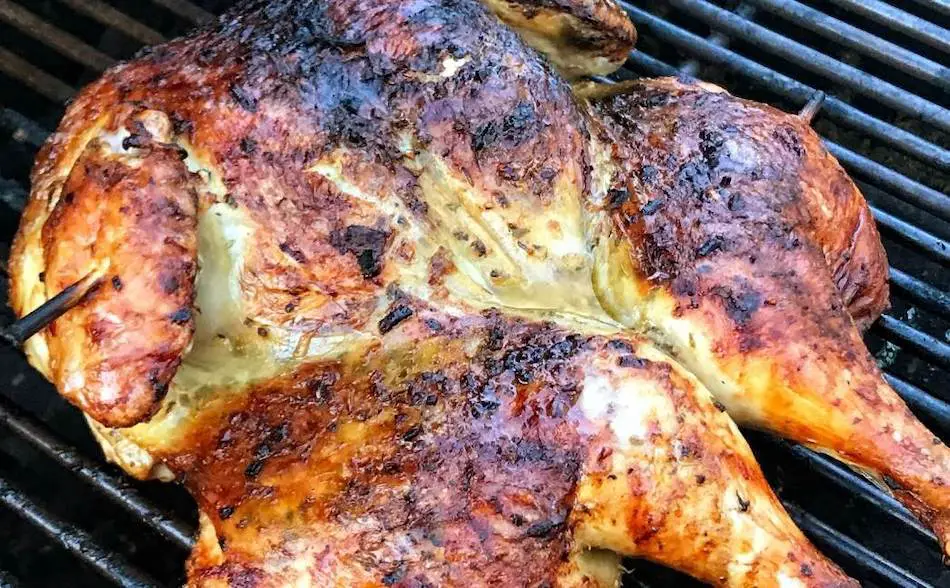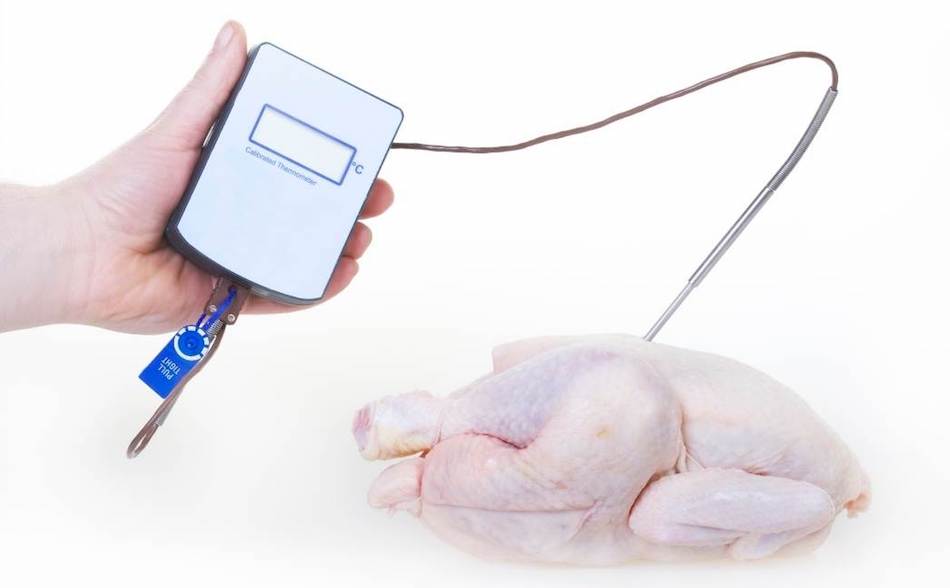
If you’re looking to impress your friends and family with a delicious barbecue feast, spatchcocked chicken on a pellet grill is a surefire way to do it. Not only is spatchcocked chicken flavorful and juicy, but it’s also surprisingly easy to make.
Spatchcocked chicken is a technique in which the backbone of a chicken is removed and the bird is flattened for grilling or roasting. This method allows for even cooking and a crispy skin, and is favored by pitmasters and chefs for its quick cook time and bold flavor. When cooking spatchcocked chicken on a pellet grill, smoking the meat can add an extra layer of flavor. To achieve the best results, it is important to cook the chicken low and slow in order to infuse it with a delicious smoky flavor and keep it moist and juicy. Spatchcocking is also a great way to get maximum flavor and moisture into the meat, as the marinade or rub can penetrate the meat more effectively.
Spatchcocked Chicken On A Traeger

Ingredients
- 1 whole chicken
- Barbecue rub
Instructions
- Place the chicken with the breast side facing downwards.
- Locate the spine, and cut either side of the backbone all the way along the bird.
- Pull out the spine, and clean out the hollow cavity of the bird. Sometimes there are bits of liver and heart in the cavity, so it’s best to clean that out.
- Then flip over the bird, and have the breast facing upwards.
- Hold your hands over the bird as if you are about to perform CPR.
- Press down on the breast until you hear a crack. Your bird will then be spatchcocked and ready for the grill.
- Fire up your Traeger to around about 300° F.
- Dry the chicken with a paper towel to ensure you get crispy skin.
- You can apply a binder to the chicken, allowing the rub to stick much better. However, this step is optional. I use either olive oil or yellow mustard.
- Apply a layer of seasoning with salt, pepper, and garlic. Then apply a layer of your favorite barbecue rub. Beware of the salt content if you’ve already salted the chicken.
- Choose a mild smoking wood such as apple or cherry, or a 50/50 mix over fruitwood with a strong smoking wood such as hickory or oak. Pecan is always a safe choice.
- Place the spatchcocked bird on the grill.
- Spray the chicken every 30 minutes with olive oil spray or cooking spray.
- Cook for 1 and 1/2 hours, and monitor the internal meat temperature.
- Ensure the internal meat temperature of the chicken reaches 165° F in the breast and 170° F in the thigh.
- Let the chicken rest for 20 minutes, and then slice
Nutrition Information:
Serving Size:
50 gramsAmount Per Serving: Calories: 55.9Total Fat: 0.7 gramsg
What The Experts Say
Here’s what the experts have to say about this tasty dish:
- “Spatchcocking a chicken allows for even cooking and a crispy skin.” – Franklin Barbecue (barbecue pitmaster)
- “Spatchcocked chicken is my go-to for a quick and flavorful dinner.” – Bobby Flay (celebrity chef)
Spatchcocking, also known as butterflying, is a technique that involves removing the backbone of a chicken and flattening it out for grilling or roasting. As BBQ pitmaster Franklin Barbecue points out, this method allows for even cooking and a crispy skin. Celebrity chef Bobby Flay is also a fan of spatchcocked chicken for its quick cook time and bold flavor.
- “Smoked chicken is always a crowd pleaser and it’s so easy to do at home.” – Aaron Franklin (barbecue pitmaster)
- “The key to a perfect smoked chicken is low and slow cooking.” – Melissa Cookston (barbecue expert)
If you’re using a pellet grill to cook your spatchcocked chicken, you may want to consider smoking it for added flavor. According to Aaron Franklin, one of the best things about smoked chicken is that it’s easy to make at home. BBQ expert Melissa Cookston agrees, adding that the key to a perfect smoked chicken is cooking it low and slow. This method helps to infuse the chicken with a delicious smoky flavor, as well as keep it moist and juicy.
- “Spatchcocking is a great way to get maximum flavor and moisture into the chicken.” – Andrew Zimmern (food critic)
- “I love spatchcocked chicken because it cooks evenly and the skin gets super crispy.” – Chris Lilly (barbecue pitmaster)
In addition to its faster cook time, spatchcocking is also a great way to get maximum flavor and moisture into the meat. As food critic Andrew Zimmern points out, spatchcocking allows the marinade or rub to penetrate the meat more
Why Spatchcock Chicken Before Smoking?
Spatchcocking is one of the best techniques to use when smoking chicken on a pellet grill. Also known as butterflying, a spatchcocked chicken will flatten the bird, helping it to get a more even cook. This technique is fairly straightforward. Once you’ve done it a few times, you’ll get the hang of it. Not only does it work with chicken, spatchcocking also makes it easier to cook turkey.
“Dry Smoked Chicken? Here’s Why”
Spatchcocking is a Safer Way to Cook Chicken
Not only does spatchcocking chicken save time, but it also guarantees that your bird is safe to eat. Chicken contains a lot of bacteria, so it’s extremely important that it’s cooked thoroughly. If you’re cooking a whole bird, there may be sections on the outside that look done, but another section could be underdone. Spatchcocking ensures all parts of the chicken is cooked evenly.
Cooking chicken can be a bit intimidating, especially if you’re worried about food poisoning. That’s why it’s so important to follow some basic guidelines to keep your chicken safe. First and foremost, you must use a food thermometer. The USDA recommends cooking chicken to at least 165 degrees Fahrenheit to kill off any harmful bacteria that might be lurking in the meat. When you’re inserting the thermometer, make sure you stick it in the thickest part of the chicken without touching the bone. The bone can conduct heat and give you a false reading.
Chicken produces bacteria such as salmonella, staphylococcus aureus, E. coli, etc. Always use an instant-read thermometer that is accurate to ensure that your meat is safe to eat.

Bacteria multiply in temperatures between 40° F and 140° F. Always keep your chicken above this temperature when cooking. Ensure the chicken has been thawed thoroughly if you’re smoking a frozen bird. The problem with smoking a frozen chicken is the outside could be cooked, but the inside might still be raw or underdone.
Smoking meat on a Traeger will give the chicken a smoke ring. This can deceive because it will make the chicken look pink in some sections. Make sure you insert your thermometer probe into those sections to ensure they are above 165° F.
Now, in addition to using a thermometer, you also need to be careful about how you handle and store your chicken. Wash your hands thoroughly before and after handling raw chicken, and keep raw chicken separate from other foods in the fridge to avoid cross-contamination. If you’re storing cooked chicken, make sure you put it in the fridge within two hours of cooking (or within one hour if it’s really hot outside).
For more on thermometers, check out my Thermometer Guide
Where To Place Chicken In A Traeger Pellet Grill
Most pellet grills have hot spots and cool spots. It’s always a good idea to rotate the meat around the grill during the cook. Always point the thighs and the legs towards the hottest part of the pellet grill or smoker. You want to shield the breast as much as possible because it is lean and contains little fat, so it dries out.
When it comes to cooking on a pellet grill, there are a few things to consider in terms of even cooking. First off, pellet grills are generally pretty good at maintaining even temperatures across the cooking surface. However, there may be some slight variations in temperature from one area to another, depending on the design of the grill and the distribution of the heat.
Now, in terms of the hot and cool areas of a pellet grill, it’s important to remember that heat tends to rise. This means that the top of the grill will generally be a bit hotter than the bottom. Some pellet grills also have a “hotspot” on one side or the other, which can result in slightly uneven cooking.
So, when you’re placing your meat on the grill, it’s a good idea to take these temperature variations into account. If you’ve got a piece of meat that’s really thick, you might want to put it on the cooler side of the grill to give it more time to cook through without burning. On the other hand, if you’ve got a thin cut of meat that you want to cook quickly, you might want to put it on the hotter side of the grill.
Overall, pellet grills are pretty good at producing even temperatures, but it’s always a good idea to keep an eye on your food as it cooks and move it around as needed to ensure even cooking. And remember, the best way to gauge the doneness of your meat is with a food thermometer – it’s the only way to be sure.

When Is Chicken Done?
Chicken contains a lot of bacteria, so you want to make sure it’s in a safe range. The ideal temperature to serve chicken is 165° F in the breast and 175° F in the thigh. The thigh and legs take a little longer to cook, as it contains red meat with a lot of fat and blood vessels.
When it comes to cooking chicken, safety is of the utmost importance. As you would know, chicken can contain all sorts of harmful bacteria, like Salmonella, that can give you food poisoning if you’re not careful. That’s why it’s so important to make sure your chicken is cooked to the right temperature. Again, the ideal temperature to serve chicken is 165° F in the breast and 175° F in the thigh.
The reason the temperature is a little higher in the thigh is because the thighs and legs contain red meat with a lot of fat and blood vessels. These parts of the chicken take a little longer to cook, so you want to make sure they reach a higher temperature to kill off any bacteria that might be lurking in the meat.
So, when you’re cooking chicken, make sure you use a food thermometer to check the internal temperature of the meat. Stick it in the thickest part of the breast and the thigh to make sure you’re hitting those safe temperatures. And remember, the only way to be sure your chicken is safe to eat is to use a thermometer. Trust me, it’s worth the extra step to ensure that your chicken is cooked to perfection and safe for you and your family to enjoy.
“Chicken Wings On A Traeger – We Asked The Pros”
How Long Does It Take To Cook Chicken In A Traeger Pellet Grill?
In general, chicken takes about 1- 2 hours to cook in a Traeger at around the 300° F range. Obviously, much depends on the size of the chicken and your cooking temperature. Chicken is so versatile, and once it is smoked, you can shred it, chop it up into pieces, etc. Chicken is easy to cook on a Traeger, but it’s also cheap and the number one selling meat in the USA.
How To Avoid Dry Chicken
Once you go over the 165° F to 175° F internal meat temperature range, you will put the chicken at risk of drying out. Use a good thermometer to alert you when the meat hits the correct internal temperature. If you do this, and I can guarantee you to have tender, juicy chicken.
When it comes to cooking chicken, one thing that can really ruin a dish is dry meat. Nobody likes a dry, flavorless chicken breast, right? So how can we avoid it?
Well, the main cause of dry chicken is simply overcooking. Chicken is a lean meat, which means it doesn’t have a lot of fat to keep it moist as it cooks. If you cook the chicken for too long, the heat will cause the moisture in the meat to evaporate, leaving you with a dry, flavorless piece of poultry.
So, the key to avoiding dry chicken is to cook it just until it reaches the right temperature. The USDA recommends cooking chicken to at least 165° F in the breast and 175° F in the thigh. These temperatures are high enough to kill any harmful bacteria that might be present in the meat, but not so high that they cause the chicken to dry out.
Another way to prevent dry chicken is to use a marinade or rub to add moisture and flavor to the meat. A good marinade can help to keep the chicken moist as it cooks, and can also add a ton of flavor to the finished dish.
“Chicken Wings On A Traeger – We Asked The Pros”
How To Get A Crispy Skin On A Spatchcocked Chicken
- To get a crispy skin on chicken, you need to cook in the 300° F range. Once you go below 275° F, the chicken skin will be soft and rubbery.
- Make sure you dry the chicken skin prior to cooking. If your skin is moist, it will not be as crispy.
- Spray the skin or the bird every 30 minutes, which will help with the browning effect.
- Don’t soak the bird in brine if you really want crispy skin. Soaking the bird in brine is a great way to get some extra flavor into the chicken, but it may cause the skin to go soft and rubbery. If you soak the bird, just air it on an earring rack or dry it with a paper towel afterward.
- Don’t cook the chicken in a pan, as this will make the bottom of the bird soggy.
- Avoid foiling the bird at any stage of the cook. This will create steam, which will soften the skin.
Use Good Meat Thermometers
Use good thermometers because you want to cook to internal meat temperature, not time. I wouldn’t trust any thermometer that comes with my smoker—Traeger included. Get yourself a decent thermometer and an instant-read for under $100.
You don’t need to spend a lot of money on thermometers. For years, I have used a $50 meat thermometer and a $30 instant-read. Both are highly accurate, and have solid reputations. The wireless leave-in thermometers is the TP20, which you can see here on Amazon. The instant-read I use in the TP19, you can check here.

USDA Safety Recommendations For Chicken
According to the USDA, the chicken leg should be cooked to a safe internal temperature of 165° F. However, I always take legs and thighs over 170° F. Spatchcocking will make cooking chicken much safer. You’ll get a more even cook, and the temperature won’t be overdone on one section and underdone on another part of the bird.
Chicken produces bacteria such as salmonella, staphylococcus aureus, E. coli, etc. Always use an instant-read thermometer that is accurate to ensure that your meat is safe to eat.
Bacteria multiply in temperatures between 40° F and 140° F. Always keep your chicken above this temperature when cooking. Ensure the chicken has been thawed thoroughly if you’re smoking a frozen bird. The problem with smoking a frozen chicken is the outside could be cooked, but the inside might still be raw or underdone.
Smoking meat on a Traeger will give the chicken a smoke ring. This can deceive because it will make the chicken look pink in some sections. Make sure you insert your thermometer probe into those sections to ensure they are above 165° F.
Best Dry Rubs For Smoking Meat
Standard Barbecue Rub

I found this great rub recipe through How To BBQ Right. I use this recipe and alter it slightly depending on what I'm cooking. Made by the guys at Townsend Spice & Supply: https://townsendspice.com/
Ingredients
- - ½ Cup Paprika
- - ½ Cup Salt
- - ½ Cup Sugar
- - ½ Cup Granulated Garlic
- - ¼ Cup Granulated Onion
- - ¼ Cup Chili
- - ¼ Cup Cumin
- - 2 Tablespoons Black Pepper
- - 2 Tablespoons Dry Mustard
- - 1 Tablespoon Cayenne Pepper
Instructions
- Combine all the spices together in a large mixing bowl
- Store rub in rub shakers
My Favorite Meat Smoking Tools
Thanks for checking out this article. I hope you learned a few things. Here are some of my favorite tools I use when smoking brisket that may be useful to you. These are affiliate links, so if you decide to purchase any of these products, I’ll earn a commission. But in all honesty, these are the tools I recommend to my family and friends who are just starting out.
Meat Thermometer: There are dozens of fancy thermometers on the market, but I still use my trusty TP20. For around $50, I have a high-quality meat thermometer with two probes, and can track the temperature of my smoker with one probe, and my meat with the other probe. The ThermoPro TP20 is an Amazon Best Seller because it’s the easiest thermometer to operate, is durable, highly accurate, and comes with pre-programmed meat settings.
Instant Read Thermometer: Arguably, the second most important tool you need is a fast and accurate instant-read thermometer. These tools play an important role in the latter stages of the cook when the meat needs regular checking in multiple areas. I use the ThermoPro TP19 because it can do everything a ThermaPen can do, but for a fraction of the cost. You can check out the TP19 on Amazon here.
Wireless Thermometer: The latest thermometers on the market have no wires and can be controlled by wi-fi via your phone. Airprobe 3 is the best of this technology.
Butcher Paper: Wrapping brisket in butcher paper has become a huge trend in barbeque thanks to Aaron Franklin. Wrapping your brisket in paper will give you a nice brisket bark. However, you can’t just use any old paper, it has to be unwaxed, food grade paper. You can find it on Amazon here.
Advanced Thermometer and Automatic Temperature Controller: Once you’re ready to take things seriously, the FireBoard 2 Drive is a six-channel Bluetooth/Wi-Fi thermometer that can monitor up to 6 pieces of meat, control and graph your cook sessions on your smartphone, and attaches to an an automatic blower that will convert your charcoal smoker to a set-and-forget. This is one of the most advanced meat thermometers on the market. You can check it out on the FireBoard website here.
More Articles:
How To Smoke Chicken Breast On A Traeger Pellet Grill (Without Drying It Out)
Smoked Chicken Done Temp – Safe Internal Temperatures
